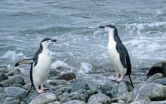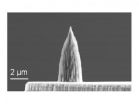(Press-News.org) The breeding population of chinstrap penguins has declined significantly as temperatures have rapidly warmed on the Antarctic Peninsula, according to researchers funded in part by the National Science Foundation (NSF).
The study indicates that changing climatic conditions, rather than the impact of tourism, have had the greatest effect on the chinstrap population.
Ron Naveen, founder of a nonprofit science and conservation organization, Oceanites, Inc., of Chevy Chase, Md., documented the decline in a paper published in the journal Polar Biology. Naveen and coauthor Heather Lynch, of Stony Brook University, are researchers with the Antarctic Site Inventory (ASI).
The paper's findings are based on an analysis of data collected during fieldwork conducted in December 2011 at Deception Island, one of Antarctica's busiest tourist locations.
"We now know that two of the three predominant penguin species in the peninsula--chinstrap and Adélie--are declining significantly in a region where, in the last 60 years, it's warmed by 3 degrees Celsius (5 degrees Fahrenheit) annually and by 5 degrees Celsius (9 degrees Fahrenheit) in winter," said Naveen. "By contrast, Gentoo penguins are expanding both in numbers and in range. These divergent responses are an ongoing focus of our Inventory work effort."
The ASI has been collecting and analyzing Antarctic Peninsula-wide penguin population data since 1994, and these new findings have important implications both for the advancement of Antarctic science and the management of Antarctica by the Antarctic Treaty nations. The United States is a signatory to the Treaty.
The Inventory is supported in part by NSF's Office of Polar Programs and also by public contributions. The project's fieldwork at Deception Island was assisted by a grant from The Tinker Foundation.
Through Polar Programs, NSF carries out its presidential mandate to manage the U.S. Antarctic Program, which coordinates all U.S. research on the southernmost continent and in the Southern Ocean.
ASI is the only science project tracking penguin population changes throughout the entire Antarctic Peninsula region.
"Our Deception Island work, using the yacht Pelagic as our base, occurred over 12 days and in the harshest of conditions--persistent clouds, precipitation and high winds, the latter sometimes reaching gale force and requiring a lot of patience waiting out the blows. But, in the end, we achieved the first-ever, one-season survey of all chinstraps breeding on the island," Naveen said.
There has been speculation that tourism may have a negative impact on breeding chinstrap penguins--especially at Deception Island's largest chinstrap colony, known as Baily Head.
Naveen oversaw the Deception Island census effort. Lynch, the Inventory's chief scientist, undertook subsequent analyses.
The results and analyses, according to Lynch, shed new light on the massive changes occurring in this region.
"Our team found 79,849 breeding pairs of chinstrap penguins at Deception, including 50,408 breeding pairs at Baily Head. Combined with a simulation designed to capture uncertainty in an earlier population estimate, there is strong evidence to suggest a significant decline, greater than 50 percent, in the abundance of chinstraps breeding at Baily Head since 1986-87.
"The decline of chinstrap penguins at Baily Head is consistent with declines in this species throughout the region, including at sites that receive little or no tourism; further, as a consequence of regional environmental changes that currently represent the dominant influence on penguin dynamics, we cannot ascribe any direct link in this study between chinstrap declines and tourism."
The Baily Head analysis was abetted by Lynch's analyses of high-resolution satellite imagery. Images for the 2002-03 and the 2009-10 seasons suggest a 39-percent decline during that seven-year period, providing independent confirmation of this population decline.
Through support from NSF and a cooperative effort with the University of Minnesota's Polar Geospatial Center, the ASI continues to demonstrate the use of satellite imagery to analyze and describe environmental change in sensitive habitats.
Adds Lynch, "While there has been considerable focus in the policy and management community about the potential impact of tourism on these penguin populations, we cannot forget the overwhelming evidence that climate is responsible for the dramatic changes that we are seeing on the peninsula. If tourism is having a negative impact on these populations, it's too small an effect to be detected against the background of climate change."
INFORMATION:
The other ASI researchers on the team were Steven Forrest, of Oceanites, Inc.; Thomas Mueller of the Biodiversity and Climate Research Centre and Michael Polito of the University of North Carolina, Wilmington.
Changing climate, not tourism, seems to be driving decline in chinstrap-penguin populations
High-resolution satellite imagery aids in study
2012-11-14
ELSE PRESS RELEASES FROM THIS DATE:
Preserving van Gogh's priceless masterpieces
2012-11-14
The chrome yellow pigment that renowned post-Impressionist artist Vincent van Gogh favored in priceless masterpieces like Sunflowers, the Yellow House and Wheatfield with Crows is especially sensitive to certain types of light and should be protected to prevent darkening. That's the conclusion of a series of studies in ACS' journal Analytical Chemistry, which could help preserve masterpieces by van Gogh and contemporaries like Gauguin, Cézanne and others.
Koen Janssens and colleagues explain that the chrome yellow pigment used by van Gogh and others in the 19th and 20th ...
Boosting the sensitivity of airport security screening
2012-11-14
Scientists are reporting a simple way to improve the sensitivity of the test often used to detect traces of explosives on the hands, carry-ons and other possessions of passengers at airport security screening stations. Their report appears in ACS' The Journal of Physical Chemistry C.
Yehuda Zeiri and colleagues explain that most tests for traces of explosives begin by rubbing a swab made from glass fiber, Teflon or cotton over the suspect material. Analysis of the swab in a detector — usually a device called an ion mobility spectrometer — alerts agents to any explosive ...
Ingredient in diarrhea medicine leads to sustainable new farm fertilizer
2012-11-14
The search for a sustainable slow-release fertilizer — a key to sustaining global food production at a time of burgeoning population growth — has led scientists to an ingredient used in some diarrhea medicines. They describe use of the substance, attapulgite, as a "carrier" for plant nutrients in a report in ACS' journal Industrial & Engineering Chemistry Research.
Boli Ni and colleagues explain that about half of the 150 million tons of fertilizer used worldwide every year goes to waste. That's because most fertilizers release nutrients too fast for the crops to use. ...
Nanometer-scale diamond tips improve nano-manufacturing
2012-11-14
One of the most promising innovations of nanotechnology has been the ability to perform rapid nanofabrication using nanometer-scale tips. The fabrication speed can be dramatically increased by using heat. High speed and high temperature have been known to degrade the tip… until now.
"Thermal processing is widely used in manufacturing," according to William King, the College of Engineering Bliss Professor at the University of Illinois at Urbana-Champaign. "We have been working to shrink thermal processing to the nanometer scale, where we can use a nanometer-scale heat ...
Life and death in a star-forming cloud
2012-11-14
The aftershock of a stellar explosion rippling through space is captured in this new view of supernova remnant W44, which combines far-infrared and X-ray data from ESA's Herschel and XMM-Newton space observatories.
W44, located around 10 000 light-years away within a forest of dense star-forming clouds in the constellation of Aquila, the Eagle, is one of the best examples of a supernova remnant interacting with its parent molecular cloud.
The product of a massive star that has already reached the end of its life and expelled its outer layers in a dramatic explosion, ...
You can be a star -- on science's stage
2012-11-14
The rapid growth in "citizen science" projects during the past decade is enabling more and more science enthusiasts, hobbyists, students and other ordinary people to participate in the excitement of real-world scientific research and help solve serious scientific mysteries. That's the topic of the cover story in Chemical & Engineering News (C&EN), the weekly newsmagazine of the American Chemical Society, the world's largest scientific society.
Deirdre Lockwood, C&EN contributing editor, traces the growth of citizen science from the Audubon Christmas Bird Count of 1900 ...
Television: Chronicle of a death foretold?
2012-11-14
Not only is TV not endangered, but it also has a unifying social impact on the nuclear family across the country. This is the main conclusion of a cross-Canada study—Are the Kids All Right?—on the television viewing habits of families with at least one child aged between 9 and 12 years. The study was conducted by a team of researchers led by André H. Caron, professor of communications at Université de Montréal and Director of the Centre for Youth and Media Studies (CYMS).
"Young Canadians today live in a different world than that experienced by previous generations. In ...
Could poor sleep contribute to symptoms of schizophrenia?
2012-11-14
Neuroscientists studying the link between poor sleep and schizophrenia have found that irregular sleep patterns and desynchronised brain activity during sleep could trigger some of the disease's symptoms. The findings, published in the journal Neuron, suggest that these prolonged disturbances might be a cause and not just a consequence of the disorder's debilitating effects.
The possible link between poor sleep and schizophrenia prompted the research team, led by scientists from the University of Bristol, the Lilly Centre for Cognitive Neuroscience and funded by the ...
World's largest respiratory genetics study launches on World COPD Day
2012-11-14
Researchers from the Universities of Nottingham and Leicester are leading the largest ever study of the genetics relating to lung disease.
The project will investigate what determines an individual's lung health and why smoking harms the lungs of some people more than others and will use health information held by UK Biobank, a major national resource holding health information from half a million volunteers.
The study, funded by the Medical Research Council (MRC) and also involving scientists at St George's, University of London, is aiming to shed light on why some ...
How safe are our roads for Bradley and the nation's cyclists?
2012-11-14
A new government-funded study is to be carried out into how Britain's roads could be made safer for cyclists to reduce the risk of cycling injuries, encourage more people to use bikes and improve public health.
Amid fresh calls for action on road safety after the recent separate accidents involving world-famous cyclist Bradley Wiggins and the top cycling mentor Shane Sutton, researchers at The University of Nottingham are leading a study which will assess the effectiveness of the current cycling infrastructure and ask 'which features installed for cyclists are most effective ...
LAST 30 PRESS RELEASES:
Beech trees use seasonal soil moisture to optimize water uptake
How thinning benefits growth for all trees
Researchers upgrades 3-PG forest model for improved accuracy
Achieving anti-thermal-quenching in Tb3+-doped glass scintillators via dual-channel thermally enhanced energy transfer
Liquid metal modified hexagonal boron nitride flakes for efficient electromagnetic wave absorption and thermal management
Failure mechanisms in PEM water electrolyzers
Study captures how cancer cells hide from brain immune cells, shows that removing their “don’t eat me” signals stops their escape
New breakthrough in detecting ‘ghost particles’ from the Sun
Half of people arrested in London may have undiagnosed ADHD, study finds
From dots to lines: new database catalogs human gene types using ’ACTG’ rules
Persistent antibiotic resistance of cholera-causing bacteria in Africa revealed from a multinational workshop for strengthening disease surveillance
SwRI, Trinity University to synthesize novel compound to mitigate effects of stroke, heart attack
Novel endocrine therapy giredestrant improves disease-free survival over standard of care for patients with early-stage breast cancer in phase III lidERA trial
Gen Z views world as "scary place" with growing cynicism about ability to create change
Biosensor performance doubled – New applications possible
Leveraging incomplete remote sensing for forest inventory
Key chemical in dark chocolate may slow down ageing
New 15-minute hepatitis C test paves the way for same-day treatment
Uranus and Neptune might be rock giants
Magnetically actuated soft electrodes for multisite bioelectrical monitoring of ex vivo tissues
FAU engineers decode dementia type using AI and EEG brainwave analysis
Carrier-free peptide–daunorubicin–small interfering RNA nanoassembly for targeted therapy of acute myeloid leukemia
Global Virus Network announces appointment of new board members
Artificial beaver dams show promise in offsetting climate change effects
Could hidden infections be fueling long COVID?
Targeted oxygen for initial resuscitation of preterm infants
Researchers develop models to help diagnose ALS earlier through blood biomarkers
Jeonbuk National University researchers develop novel eco-friendly and photo-switchable smart adhesives
Magnetic ordering induces Jahn–Teller effect in spinel-type compounds
A mitochondrial protein may hold the secret to longevity, new study finds
[Press-News.org] Changing climate, not tourism, seems to be driving decline in chinstrap-penguin populationsHigh-resolution satellite imagery aids in study


